- SI 1 (Shào Zé, 少泽)
- SI 2 (Qián Gŭ, 前谷)
- SI 3 (Hòu Xī, 后溪)
- SI 4 (Wàn Gŭ, 腕骨)
- SI 5 (Yáng Gŭ, 阳谷)
- SI 6 (Yăng Lăo, 养老)
- SI 7 (Zhī Zhèng, 支正)
- SI 8 (Xiăo Hăi, 小海)
- SI 9 (Jiān Zhēn, 肩贞)
- SI 10 (Nào Shù, 臑俞)
- SI 11 (Tiān Zōng, 天宗)
- SI 12 (Bĭng Fēng, 秉风)
- SI 13 (Qū Yuán, 曲垣)
- SI 14 (Jiān Wài Shù, 肩外俞)
- SI 15 (Jiān Zhōng Shù, 肩中俞)
- SI 16 (Tiān Chuāng, 天窗)
- SI 17 (Tiān Róng, 天容)
- SI 18 (Quán Liáo, 颧髎)
- SI 19 (Tīng Gōng, 听宫)
There are19 bilateral points on the small intestine channel: 8 on the lateral aspect of the posterior upper limb, 7 on the shoulder and back, and 4 on the head and neck. The first is on the little fnger, SI 1 (shào zé); the last, on the face, SI 19 (tīng gōng). The points of this channel treat disorders of the small intestine, heart, chest, throat, neck, face, the fve sensory organs, and the running course of the channel.
SI 1 (Shào Zé, 少泽)
Jing-well point
Location. On the little finger 0.1 cun proximal-medial to the ulnar corner of the nail and lateral to the distal phalanx (Pic. 3-35).
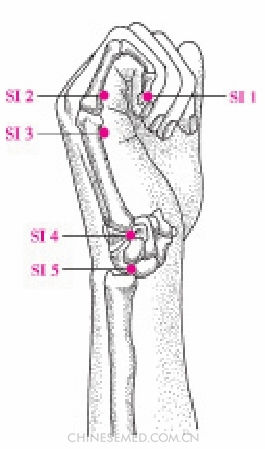
Location method. When the fst is clenched slightly, the point is at the junction of lines drawn along the ulnar border and the base of the fngernail.
Actions. Clear heat and promote lactation, disperse stasis and unblock the orifices.
Indications. Acute mastitis, insufficient lactation, coma, febrile diseases; headache, superficial visual obstruction, deafiness, pharyngitis, curled tongue, stiff tongue, inability to speak; chills and fever, malaria; pain in the upper arm, immobility of the little fnger.
Manipulation. Acupuncture: 1. Needle shallowly 0.1~0.2 cun to induce distention at the local region. 2. Bleed with a three-edged needle. Moxibustion: Use 1~3 cones of cone moxibustion or a moxa stick for 3~5 minutes.
Precautions. Be careful when treating pregnant patients. Scarring moxibustion is not suitable.
Annotation. The point originated in The Spiritual Pivot (Líng Shū, 灵枢). Shào means small; zé means moisten. The hand taiyang channel governs the thick fuids that moisturize the body. The jingwell point is where the channel qi begins; thus it is called shào zé, small marsh.
Modern clinical observation and research. To evaluate the therapeutic effects of EA at SI 1 (shào zé) on insufficient lactation, 92 patients of different ages with insufficient lactation due to various syndromes were randomly and equally divided into treatment and control. The former were treated bilaterally at SI 1; the latter, bilaterally at LI 1 (shāng yáng). Both groups received two courses of fve treatments each and a one-month follow up. The treatment group significantly surpassed the control group in increased lactation and prolactin levels (P<0.01).1
SI 2 (Qián Gŭ, 前谷)
Ying-spring point
Location. On the little fnger in the depression distal to the ulnar side of the fifth metacarpophalangeal joint at the border between the red and white fesh (Pic. 3-35).
Location method. When the fist is slightly flexed, the point is at the ulnar end of the palmar metacarpophalangeal crease of the little fnger.
Actions. Disperse wind and dissipate heat, clear the head and improve vision, unblock channels, and quicken collaterals.
Indications. Febrile diseases without perspiration, chills and fever, malaria; eye pain, tearing, visual obstruction, tinnitus, nasal congestion, nosebleed, swollen cheek, swelling in the throat, pharyngitis; headache, painful and stiff neck, inability to rotate neck, pain and inability to raise the arm; no lactation after postpartum.
Manipulation. Acupuncture: Needle 0.2~0.3 cun perpendicularly to produce local distention. Moxibustion: Use 1~3 cones of cone moxibustion, or use a moxa stick for 5~10 minutes.
Precautions. Scarring moxibustion is not suitable.
1 Wei L, Wang H, Han Y, Li C. Clinical observation on the effects of electroacupuncture at SI 1 (shào zé) in 46 cases of postpartum Insufficient lactation. J Tradit Chin Med. 2008; 28(3): 168-72.
Annotation. The point originated in The Spiritual Pivot (Líng Shū, 灵枢). Qián means front. The point is in front of the fifth metacarpophalangeal joint in a depression like a valley, so it was named qián gŭ, front valley.
SI 3 (Hòu Xī, 后溪)
Shu-stream point; confuence point of the du mai
Location. On the dorsum of the hand in the depression proximal to the ulnar side of the fifth metacarpophalangeal joint at the border between the red and white fesh (Pic. 3-35).
Actions. Clear the head, improve vision, calm the mind and spirit, unblock channels, and quicken collaterals.
Indications. Febrile diseases without perspiration, chills and fever, malaria, jaundice; eye pain, tearing, visual obstruction, red eyes, dizziness, tinnitus, deafiness, nasal congestion, nosebleed, swollen cheek, swelling of the throat, pharyngitis; depression, mania, epilepsy, visceral agitation, insomnia, stroke; headache, painful stiff neck, inability to rotate neck, neck and shoulder pain, elbow spasm and pain, arm and little finger pain, hemiplegia, inability to raise the arm; chest fullness, abdominal distention, dyspnea, no lactation after postpartum.
Manipulation. Acupuncture: Needle 0.5~0.8 cun perpendicularly; soreness and distention will radiate toward the palm. Deep insertion can penetrate LI 4 (hé gŭ). Moxibustion: Use 1~3 cones of cone moxibustion or use a moxa stick for 5~10 minutes.
Annotation. The point originated in The Spiritual Pivot (Líng Shū, 灵枢). Hòu means behind; xī means stream. With the fst clenched, the point is at the ulnar end of the transverse crease, which is shaped like a stream, so it was named back stream.
Modern clinical observation and research. In a study on acute torticollis, patients were needled on the ipsilateral side at SI 3 and Luo Zhen (M-UE-24)1. Outcome was determined by measuring the angle of lateral head rotation with a compass and protractor before and after treatment. Mean improvement was 52.9%; those presenting earlier (<24 hours) as opposed to later (>72 hours) had better results (P=0.034). The researcher suggested that such objective parameters should be incorporated into acute and chronic neck pain studies.2
SI 4 (Wàn Gŭ, 腕骨)
Yuan-source point
Location. On the posterolateral aspect of the wrist in the depression between the base of the fifth metacarpal and the triquetrum at the border between the red and white fesh (Pic. 3-35).
Location method. Slide a fnger from SI 3 (hòu xī) proximally along the fifth metacarpal bone to the bony projection; the point is in the depression between these bones.
Actions. Drain dampness, decrease jaundice, unblock the orifices, quicken collaterals, and increase body fuids to relieve thirst.
Indications. Chills and fever, jaundice, febrile diseases without perspiration, malaria; recurrent headache, headache, swelling of the neck and jaws, tearing, visual obstruction, tinnitus; hemiplegia, inability to fex the arm and elbow, spasm and pain in the fve fngers; consumptive thirst, depression, mania, infantile convulsion, convulsion.
Manipulation. Acupuncture: Needle 0.3~0.5 cun perpendicularly; local soreness and distention can spread to the palm. Moxibustion: Use 3~5 cones of cone moxibustion, or use warming needle moxibustion for 20 minutes, or use a moxa stick for 5~10 minutes.
1 This point is called wài láo gōng (EX-UE 8, 外劳宫).
2 Samuels N. Acupuncture for acute torticollis: a pilot study. Am J Chin Med. 2003; 31(5): 803-7.
Precautions. Scarring moxibustion is not suitable.
Annotation. The point originated in The Spiritual Pivot (Líng Shū, 灵枢). It is located in the depression inferior to the pisiform, so it is called wàn gŭ, wrist bone.
SI 5 (Yáng Gŭ, 阳谷)
Jing-river point
Location. On the posterolateral aspect of the wrist in the depression between the triquetrum and the styloid process of the ulna (Pic. 3-35).
Actions. Clear heart heat, improve vision, suppress fright, and boost hearing.
Indications. Febrile diseases without perspiration, chills and fever; headache, tinnitus, deafiness, pain in the eyes, dizziness, dental caries and pain, stiff tongue, swelling of neck and jaw; depression, mania, epilepsy; pain and inability to raise the shoulder, pain in the arm and posterior aspect of the wrist, chest and hypochondriac pain.
Manipulation. Acupuncture: Needle 0.3~0.5 cun perpendicularly; local soreness and distention can spread to the wrist. Moxibustion: Use 3~5 cones of cone moxibustion, or use warming needle moxibustion for 20 minutes, or use a moxa stick for 5~10 minutes.
Precautions. Scarring moxibustion is not suitable.
Annotation. The point originated in The Spiritual Pivot (Líng Shū, 灵枢); it is on the lateral side of the hand in the valley-like depression between the triquetrum and the styloid process of the ulna. The lateral side belongs to yang, so the point is called yáng gŭ, yang valley.
SI 6 (Yăng Lăo, 养老)
Xi-cleft point
Location. On the posterolateral aspect of the forearm in the depression radial to the head of the ulnar bone, 1 cun proximal to the dorsal wrist crease (Pic. 3-36).
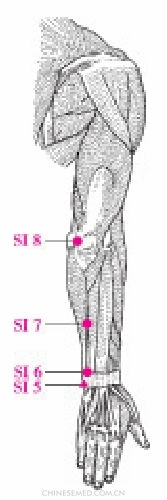
Location method. With the palm facing downward, press the highest point of the head of ulna with one finger and turn the palm toward the chest; the point is in the cleft between the bones where the finger slides (Pic. 3-37).
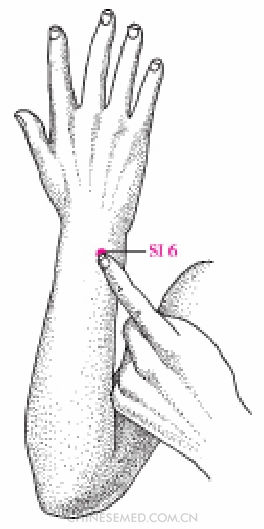
Actions. Improve vision, clear heat, relax sinews, and quicken collaterals.
Indications. Blurred vision, visual obstruction; aching pain in shoulder and arm, pain and inability to raise the arm, redness and swelling in the outer elbow, headache, facial pain; acute lumbar pain, acute lumbar sprain, hemiplegia.
Manipulation. Acupuncture: Needle 0.5~0.8 cun obliquely upward. The patient should experience soreness and numbness at the wrist that can radiate to the shoulder and elbow. Moxibustion: Use 3~5 cones of cone moxibustion or use a moxa stick for 10~20 minutes. To preserve health, moxibustion may be performed until the skin reddens.
Annotation. The point originated in The Systematic Classic of Acupuncture and Moxibustion (Zhēn Jiŭ Jiă Yĭ Jīng, 针灸甲乙经). Yăng lăo means caring for the elderly; this point treats agerelated ailments such as deafiness, blurred vision, and shoulder and arm pain.
SI 7 (Zhī Zhèng, 支正)
Luo-connecting point
Location. On the posterolateral aspect of the forearm between the medial border of the ulna and the fexor carpi ulnaris, 5 cun proximal to the dorsal wrist crease (Pic. 3-36).
Location method. The point is 1 cun distal to the midpoint of a line connecting SI 5 (yáng gŭ) and SI 8 (xiăo hăi).
Actions. Clear heat, eliminate toxins, calm the mind and spirit, unblock channels, and quicken collaterals.
Indications. Headache, chills and fever; depression, mania, fright and fear, sorrow, inappropriate laughter, forgetfulness; elbow spasms, fnger pain, stiff neck.
Manipulation. Acupuncture: Needle 0.5~1.0 cun perpendicularly or obliquely; a heavy distending sensation at the local area can spread to the hand. Moxibustion: Use 3~5 cones of cone moxibustion or use warming needle moxibustion for 20 minutes, or 5~10 minutes with a moxa stick.
Annotation. The point originated in The Spiritual Pivot (Líng Shū, 灵枢). Zhī means collateral; zhèng means main channel. This is the luo-connecting point; the main channel branches here and enters the shaoyin. Thus the point was named zhī zhèng, collateral branch.
SI 8 (Xiăo Hăi, 小海)
He-sea point
Location. On the posterolateral aspect of the elbow in the depression between the olecranon and the medial epicondyle of the humerus (Pic. 3-36).
Location method. When the elbow is slightly flexed, the point is in the groove for the ulnar nerve.
Actions. Clear heat and dispel wind, calm the mind and spirit.
Indications. Aversion to cold, headache; deafiness, yellowish eyes, swelling and inflammation of the gums; depression, mania, epilepsy.
Manipulation. Acupuncture: Needle 0.2~0.3 cun perpendicularly to produce local soreness and distention. Electric sensations can radiate toward the forearm and the ulnar side of the hand. Moxibustion: Use 3~5 cones of cone moxibustion, or use warming needle moxibustion for 20 minutes, or 5~10 minutes with a moxa stick.
Annotation. The point originated in The Spiritual Pivot (Líng Shū, 灵枢); it is the he-sea point where the hand taiyang channel qi gathers like a river converges with the sea. The name of the point means small sea.
SI 9 (Jiān Zhēn, 肩贞)
Location. On the shoulder girdle posteroinferior to the shoulder joint, 1 cun superior to the posterior end of the axillary fold (Pic. 3-38).
Location method. When the arm is adducted, the point is 1 cun superior to the posterior end of the axillary fold, posterior to the deltoid muscle.
Actions. Clear heat, relieve pain, unblock collaterals, and boost hearing.
Indications. Scapula pain, arm numbness and pain, pain in the supraclavicular fossa, tinnitus, deafiness, toothache.
Manipulation. Acupuncture: 1. Needle 1.0~1.5 cun obliquely toward the back. 2. Insert toward the anterior axillary crease to produce soreness and distention at the shoulder and scapula. Numbness and electric sensations can radiate toward the shoulder and fnger tips. Moxibustion: Use 5~7 cones of cone moxibustion or use warming needle moxibustion for 20 minutes, or use a moxa stick for 10~20 minutes.
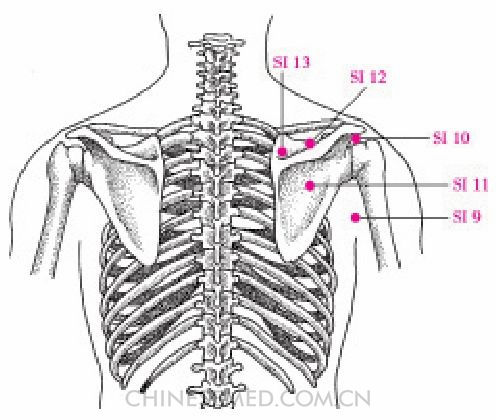
Annotation. The point originated in Basic Questions (Sù Wèn, 素问). Zhēn means true or loyal. Because it is located below the shoulder, it was named jiānzhēn, true shoulder.
Modern clinical observation andresearch. In an RCT on frozen shoulder due to cold dampness, patients were randomly given acupuncture (n=28) at LI 15 (jiānyú), SJ 14 (jiān liáo), and SI 9 (jiān zhēn) or acupuncture plus moxibustion at tender points (n=32). In the first group, 2 recovered; 9 had marked effects; 13 improved; 4 received no benefit; in the second, 7 recovered, 15 had marked effects, 9 improved; 1 received no benefit. However, there was no statistic difference between the two groups. 1
SI 10 (Nào Shù, 臑俞)
Intersecting point of hand and foot taiyang, yangwei, and yangqiao channels
Location. On the shoulder girdle superior to the posterior end of the axillary fold in the depression inferior to the spine of the scapula (Pic. 3-38).
Location method. With the patient’s arm adducted, slide your fnger directly upward from SI 9 (jiān zhēn) along the posterior axillary crease to the depression at the inferior border of the scapular spine.
Actions. Relax sinews, quicken collaterals, relieve swelling, and dissolve phlegm.
Indications. Aching pain and weakness in shoulder and arm, swelling of the shoulder; scrofula.
Manipulation. Acupuncture: Needle 0.5~1.0 cun perpendicularly. Local soreness and distention can spread to the shoulder region. Moxibustion: Use 3~5 cones of cone moxibustion, or use warming needle moxibustion for 20 minutes, or 10~20 minutes with a moxa stick.
Annotation. The point originated in The Systematic Classic of Acupuncture and Moxibustion (Zhēn Jiŭ Jiă Yĭ Jīng, 针灸甲乙经). Nào refers to the upper region of the humerus, where the point is located; hence the name, nào shù, upper arm-shu point.
SI 11 (Tiān Zōng, 天宗)
Location. At the scapular region in the depression between the upper 1/3 and lower 2/3 of a line connecting the midpoint of the spine of the scapula and the inferior angle of the scapula (Pic. 3-38).
Actions. Unblock the channels, quicken the collaterals, rectify qi, and relieve swelling.
Indications. Scapular pain, injury of shoulder and back; asthma.
1 Wang XH, Xu YZ, Hu WB, He ZG. Frozen shoulder due to cold dampness treated with acupuncture and moxibustion on tender points针刺配合痛点灸治疗寒湿型肩周炎疗效观察. Chinese Acupuncture & Moxibustion. 2010; 30(5): 364-6.
Manipulation. Acupuncture: Needle 0.5~1.0 cun perpendicularly or obliquely to produce local soreness and distention, or induce the needling sensation to radiate from the scapula to the fngers. Moxibustion: Use 3~5 cones of cone moxibustion, or use warming needle moxibustion for 20 minutes, or 5~15 minutes with a moxa stick.
Annotation. The point originated in The Systematic Classic of Acupuncture and Moxibustion (Zhēn Jiŭ Jiă Yĭ Jīng, 针灸甲乙经). Tiān means upper region or heaven; zōng means center. Because the point is in the center of the inferior scapular fossa, it was named tiān zōng, center of heaven.
SI 12 (Bĭng Fēng, 秉风)
Intersecting point of the hand yangming, hand taiyang, and hand and foot shaoyang channels
Location. At the scapular region in the supraspinous fossa superior to the midpoint of the scapular spine (Pic. 3-38).
Location method. The point is in the center of the suprascapular fossa 1 cun above the superior border of the midpoint of the scapular spine; it forms an equilateral triangle with SI 10 (nào shù) and SI 11 (tiān zōng).
Actions. Disperse wind, quicken collaterals, relieve cough, and resolve phlegm.
Indications. Pain and inability to raise the scapula, aching numbness of the upper arm.
Manipulation. Acupuncture: Needle 0.3~0.5 cun perpendicularly to produce local soreness and distention. Moxibustion: Use 3~5 cones of cone moxibustion, or use warming needle moxibustion for 20 minutes, or 10~20 minutes with a moxa stick.
Annotation. The point originated in The Systematic Classic of Acupuncture and Moxibustion (Zhēn Jiŭ Jiă Yĭ Jīng, 针灸甲乙经). Bĭng means grasping; fēng refers to pathogenic wind. Because the point relaxes the sinews and disperses wind, it is called bĭng fēng, grasping the wind.
SI 13 (Qū Yuán, 曲垣)
Location. At the scapular region in the depression superior to the medial end of the scapular spine (Pic. 3-38).
Location method. The point is at the midpoint of a line connecting SI 10 (nào shù) and the spinous process of the second thoracic vertebra.
Actions. Relax sinews, quicken collaterals, disperse wind, and relieve pain.
Indications. Scapula spasm and pain, inability to raise the scapula, aching numbness of upper arm.
Manipulation. Acupuncture: Needle 0.3~0.5 cun perpendicularly or obliquely to produce local soreness and distention. Moxibustion: Use 3~5 cones of cone moxibustion, or use warming needle moxibustion for 20 minutes, or 10~20 minutes with a moxa stick.
Precautions. Perpendicular insertion is commonly believed to be safe here, but a female treated at SI 13 (qū yuán), GB 20 (fēng chí), SI 9 (jiān zhēn), and LI 11 (qū chí) for right shoulder pain presented three hours later with chest tightness, labored breathing, and right chest and back pain that radiated toward the abdomen, more severe when she coughed. She was treated and recovered in nine days. This suggests that the shoulder joint should not be moved when needling this point, that the medial end of the scapular spine must be clearly located before insertion, and the needle should be inserted obliquely and lateroinferiorly to prevent the tip from entering the chest cavity.
Annotation. The point originated in The Systematic Classic of Acupuncture and Moxibustion (Zhēn Jiŭ Jiă Yĭ Jīng, 针灸甲乙经). Qū means crooked; yuán means wall. Located at the medial end of the supraspinous fossa, which is shaped like a crooked wall, the point is called crooked wall.
SI 14 (Jiān Wài Shù, 肩外俞)
Location. On the upper back level with the inferior border of the spinous process of the first thoracic vertebra (T1), 3 cun lateral to the posterior median line (Pic. 3-39).
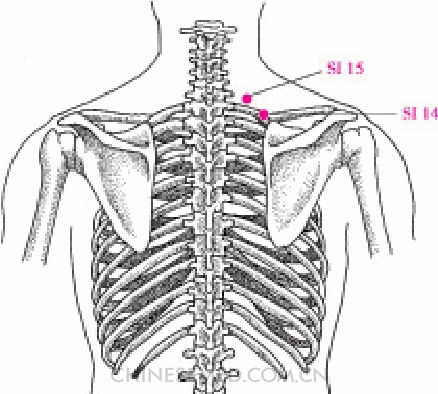
Location method. The point is at the intersection of a vertical line along the medial extremity of the scapular spine and a horizontal line inferior to the spinous process of the first thoracic vertebra.
Actions. Relax sinews, quicken collaterals, disperse wind, and relieve pain.
Indications. Aching in shoulder and back, spasms and stiff neck, cold pain of upper arm.
Manipulation. Acupuncture: Needle 0.3~ 0.5 cun obliquely and laterally to produce local soreness and distention. Moxibustion: Use 3~5 cones of cone moxibustion, or use a moxa stick for 10~15 minutes.
Precautions. Penetrating the intercostal space will injure the parietal pleura and lung. Insert along the long axis of the rib, not perpendicularly.
Annotation. The point originated in The Systematic Classic of Acupuncture and Moxibustion (Zhēn Jiŭ Jiă Yĭ Jīng, 针灸甲乙经); it is lateral to SI 15 (jiān zhōng shù), so it is called jiān wài shù, outer shoulder shu point.
SI 15 (Jiān Zhōng Shù, 肩中俞)
Location. On the upper back level with the inferior border of the spinous process of the seventh cervical vertebra (C7) and 2 cun lateral to the posterior median line (Pic. 3-39).
Actions. Disperse the lung, release the exterior, quicken collaterals, and relieve pain.
Indications. Cough, asthma, spitting of blood; aching in shoulder and back, spasms and stiff neck, cold pain of the upper arm.
Manipulation. Acupuncture: Needle 0.3~0.5 cun obliquely to produce local soreness and distention. Moxibustion: Use 3~5 cones of cone moxibustion, or use a moxa stick for 10~15 minutes.
Precautions. See SI 14 (jiān wài shù).
Annotation. The point originated in The Systematic Classic of Acupuncture and Moxibustion (Zhēn Jiŭ Jiă Yĭ Jīng, 针灸甲乙经). It is between DU 14 (dà zhuī) and GB 21 (jiān jĭng) on the shoulder, so it is called jiān zhōng shù, middle shoulder shu.
SI 16 (Tiān Chuāng, 天窗)
Location. In the anterior region of the neck posterior to the sternocleidomastoid muscle, level with the superior border of the thyroid cartilage (Pic. 3-40).
Actions. Clear the throat, boost hearing, dispel wind, and calm the spirit.
Indications. Deafiness, tinnitus, throat swelling and pain, sudden loss of voice; neck pain and stiffiness.
Manipulation. Acupuncture: Needle 0.3~0.5 cun perpendicularly; local soreness and distention can radiate to the ear, occiput, and throat. Moxibustion: Use 3~5 cones of cone moxibustion, or use a moxa stick for 5~10 minutes.
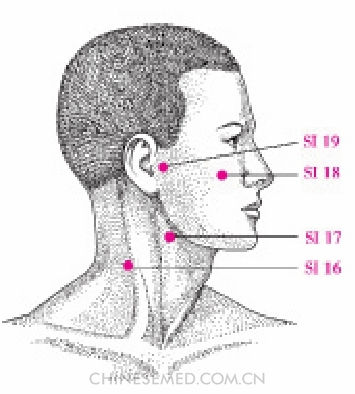
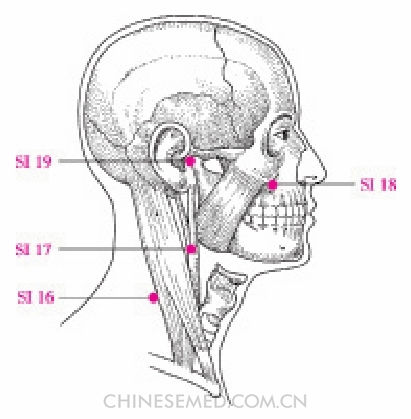
Precautions. Forceful lifting and thrusting can injure the blood vessels. Scarring moxibustion is not suitable.
Annotation. The point originated in The Spiritual Pivot (Líng Shū, 灵枢). Chuāng means opening or window and heavenly qi is associated with the small intestine, so the point is called tiānchuāng, heavenly window.
SI 17 (Tiān Róng, 天容)
Location. In the anterior region of the neck posterior to the angle of the mandible in the depression anterior to the sternocleidomastoid muscle (Pic. 3-40).
Location method. Turn the patient’s head away from the side to be needled; the sternocleidomastoid muscle is more distinct when the head is turned with resistance. The point will be level with the angle of the mandible at the anterior border of the muscle.
Actions. Boost hearing, clear the throat, clear heat, and direct counterflowing qi downward.
Indications. Throat swelling and pain, tinnitus, deafiness, swollen cheek; swelling of the nape, blocked sensation in the throat, goiter, vomiting.
Manipulation. Acupuncture: Needle 0.5~0.8 cun perpendicularly to produce local soreness and distention that can radiate to the root of the tongue and the throat. Moxibustion: Use 1~3 cones of cone moxibustion, or use a moxa stick for 5~10 minutes.
Precautions. Palpate and locate the blood vessels located near the point with one hand; with the other, insert the needle between the medial border of the sternocleidomastoid muscle and the vessels in order to prevent injury to the internal neck artery and vein. Be especially careful with patients who have hardening of the blood vessels or high blood pressure. If the blood vessels are ruptured, a large amount of blood loss can result. Scarring moxibustion is not suitable.
Annotation. The point originated in The Spiritual Pivot (Líng Shū, 灵枢). Róng means appearance, and heavenly qi is associated with the small intestine. The channel enters the face from this point; thus it is called tiān róng, heavenly appearance.
SI 18 (Quán Liáo, 颧髎)
Intersecting point of the hand shaoyang and hand taiyang channels
Location. On the face inferior to the zygomatic bone in the depression directly below the outer canthus of the eye (Pic. 3-40).
Actions. Clear heat, relieve swelling, dispel wind, and unblock collaterals.
Indications. Swollen cheek, red face, yellowish eyes, deviation of mouth and eye, twitching of eyelids, swollen gums, toothache, facial muscle spasms, facial paralysis, trigeminal nerve pain.
Manipulation. Acupuncture: Needle 0.2~0.3 cun perpendicularly to produce local soreness and distention that can radiate to half of the face. Moxibustion: Use a moxa stick for 5~10 minutes. To remove facial wrinkles, moxibustion may be administered until the skin is warm and comfortable.
Precautions. Cone moxibustion is prohibited.
Annotation. The point originated in The Systematic Classic of Acupuncture and Moxibustion (Zhēn Jiŭ Jiă Yĭ Jīng, 针灸甲乙经). Liáo means crevice beside the bone. This point is named quánliáo, cheek bone crevice, for its location at the inferior border of the zygomatic bone.
Modern clinical observation and research. In a case series, 30 patients with primary trigeminal nerve pain received acupuncture once a day at SI 18 (quán liáo), ST 7 (xià guān), LI 4 (hé gŭ) and ST 44 (nèi tíng). Needles were retained for 30~40 minutes; warming needle moxibustion was used at SI 18 and ST 7, 2~3 cones each. Ten treatments constituted a course. After three courses with 3~5 days between each, 20 recovered, 5 improved, and 5 saw no effect.1
SI 19 (Tīng Gōng, 听宫)
Intersecting point of the hand and foot shaoyang and hand taiyang channels
Location. On the face in the depression anterior to the tragus and posterior to the condyloid process of the mandible (Pic. 3-40).
Location method. With the patient supine, mouth slightly open, the point is in the depression anterior to the center of the tragus between SJ 21 (ĕr mén) and GB 2 (tīng huì).
Actions. Stimulate the ear orifce, calm the mind and spirit.
Indications. Tinnitus, deafiness, otopyorrhea; toothache.
Manipulation. Acupuncture: Needle perpendicularly 0.5~1.0 cun to produce local soreness and distention that can radiate to the ear and half of the face. Sometimes this feels as if the ear drum were bulging outward. Moxibustion: Use 3~5 cones of warming needle moxibustion, or use a moxa stick for 10~30 minutes. Natural medicinal moxibustion may be used.
Precautions. Avoid deep insertion, which can injure the neck artery and vein. Direct moxibustion is not suitable.
Annotation. The point originated in The Spiritual Pivot (Líng Shū, 灵枢). Gōng is the chief of the fve tones. This is an important point for treating ear disorders; it is named tīng gōng, main point for hearing, to imply that it can help one hear the five tones.

